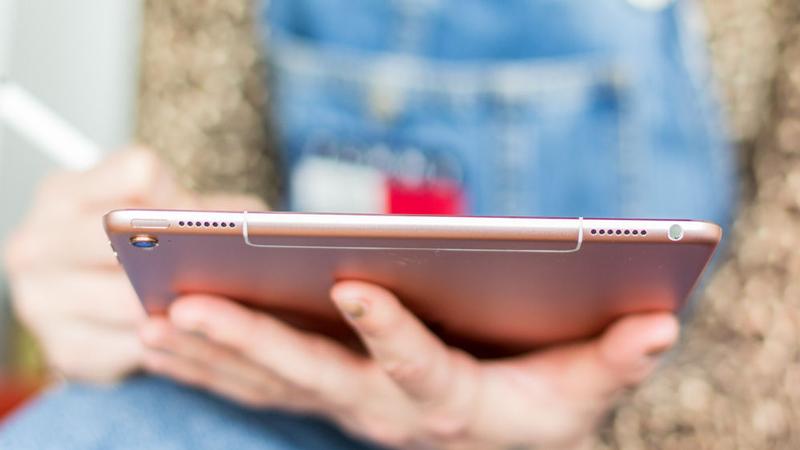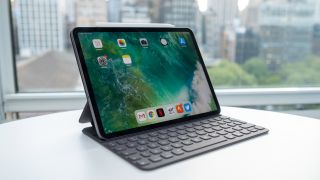The iPad Pro 9.7in, Apple’s appealing new mid-size tablet, proves that while laptops might still be the best tool for working on the go, they’re no longer necessary. In our 9.7-inch iPad Pro review, we evaluate the new iPad Pro’s build quality and new features, put the device through our rigorous speed benchmarks and battery-life tests, and compare the value for money the 9.7-inch iPad Pro offers compared to other iPads (and rival tablets) on the market
Apple unveiled a new mid-size iPad at its ‘Let us loop you in’ March press event, as we expected, but what we didn’t expect was for this to be an iPad Pro. Rather than calling this the iPad Air 3, which it logically and visually appears to be, Apple is presenting it as a shrunk-down version of the 12.9in iPad Pro – and thereby attempting to position the new 9.7-inch iPad Pro as a work device suitable for replacing a laptop, and targeted particularly at designers and illustrators on the go.
But does it succeed? In our iPad Pro 9.7in review, we evaluate the latest iPad’s design and build quality, weigh up the pros and cons of its new features, put the device through the Macworld labs’ most rigorous speed benchmark and battery tests, and compare the value for money that the iPad Pro 9.7in offers compared to the other tablets on the market.
This is a general review of the iPad Pro 9.7in, but many of its prospective buyers will be digital artists, illustrators and designers keen to make the most of its compatibility with the Apple Pencil. If that includes you, then also take a look at the more design-focused review by our colleagues at Digital Arts.

iPad Pro 9.7in review: Summary of review
Design: Physically the iPad Pro 9.7 is a close match to the iPad Air 2: weight and dimensions are identical, as is the general design (which remains sumptuous, of course). You now get four speakers – two at the top, two at the bottom – and the bottom speakers are spaced slightly further apart. This results in a much fuller, richer sound – not exactly surround sound, but a far more immersive audio experience than we’ve come to expect from a tablet. Read more about the iPad Pro 9.7in’s design
Cameras: One other noticeable physical change is the rear-facing camera, which now sticks out and will scratch on the desk if you lay the iPad flat on its back. Slightly annoying, that, although any sort of case will remove this issue, and you do get the payoff of a heavily enhanced camera setup. The rear-facing camera now has a flash, and has been pushed from 8 megapixels (on the Air 2 and the Pro 12.9in) to 12Mp; there are also numerous smaller improvements to this component.
The front-facing camera is even more dramatically boosted, going from 1.2Mp to 5Mp and gaining the Retina flash feature. We look at all this in more detail, and present a selection of test shots and comparisons, in the camera testing section, but suffice it to say that in some conditions you won’t notice the difference from the Air 2’s cameras, in others you’ll notice small improvements, and in others it’s in a whole different class.
Screen: The 9.7-inch touchscreen Retina-class display is in most respects the same as that on the Air 2: same size, same resolution and pixel density, same sharply responsive multitouch functionality. But it adds a new (and optional) feature called True Tone, designed to subtly adjust the screen’s colour output to account for environmental light conditions. And we do mean subtly – it’s a similar kind of idea to Night Shift, producing a warmer, yellower colour palette under electric lighting, but to a much less noticeable degree. We imagine most users will only be dimly aware that the screen seems to have good colour output without being sure why; we saw a clear difference only by sitting it next to the (non-True Tone) iPad Air 2 in various conditions.
Speed: Thanks to its A9X processor chip, the Pro 9.7 is significantly faster – at least on paper – than the Air 2, and in most tests very nearly as quick as the iPad Pro 12.9 despite having half as much RAM. For the time being you won’t notice much difference between the Pros and Air 2, but the older device is sure to get left behind as more and more processor-intensive apps and games are released with the newest generation of hardware in mind.
Battery: Early battery testing was also impressive, with the Pro 9.7 lasting, surprisingly, an average of 11hrs, 2m in GeekBench 3’s highly demanding benchmark despite having slightly lower battery capacity than the Air 2 (which managed just 7hrs 40m). Both devices should last longer than that in general use.

Accessories: Crucially for its credibility as a laptop replacement, the Pro 9.7 has launched alongside a new keyboard case, a 9.7in version of the Smart Keyboard, and like the Pro 12.9 it features a port on its lefthand edge for connecting to and powering this accessory. It’s about as good as an ultraportable keyboard of its size could be, but nowhere near as accurate to type on as a conventional keyboard (and some way behind the larger 12.9 version of the Smart Keyboard, too). It does a job, but you’ll need to rely on either a solid autocorrect (like the one in Pages), frequent manual corrections, or just lots of practice.
UK pricing: The Pro 9.7in starts at £499 in the UK, with prices rising to £839 for the 256GB cellular model. You’re paying a premium, then, and many Apple fans will baulk at the asking price. But we think there are enough enhancements here to justify it, and business users – if they can live with the smaller and harder-to-use keyboard attachment – will get a lot out of this device. It’s still a cool £180 cheaper than the Pro 12.9, remember, and that device doesn’t get the True Tone display or most of the camera upgrades.
That’s the summary of our iPad Pro 9.7 review, but let’s look again at each of those areas in more detail – before finally giving our definitive verdict.
[SOURCE:- MacWorld]



